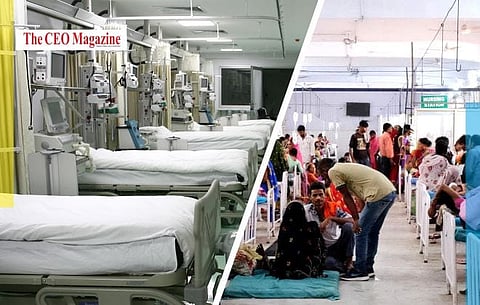
- News
- Women
- Magazine
- IndustryIndustry
- InsightsInsights
- Success Stories
- PublishPublish
- ContactContact
- Media KitMedia Kit

Indian Government Action Plan to Resolve the Existing Healthcare Challenges and Issues
India is a country that has been witnessing a paradigm shift with technology in various sectors but despite that, there have been various cases where the reality of its poor infrastructure healthcare sector has com upfront via news flashes and newspapers. Hundreds of children dying in 3 days due to oxygen shortage or shortage of staff in the public hospitals, these are just a few examples that showcased the facts about Indian Healthcare System.
Healthcare in India especially the public healthcare sector has been "subsidized" for the public in India to ensure healthcare to all. But the situation of these government aided hospitals is worse. Patients sleeping on the floor, shortage of staff, rude staff members, etc are the reality that any lower middle class or below the poverty line individual or his family will experience.
Increased gap between the poor and the rich is the real healthcare problem. While the poor have to experience the challenges of the system, the "wealthy" get to enjoy the healthcare in the private hospitals which are not mistaken to be compared with the 5 Star Hotels. The social gap between these two socioeconomic classes of the population has been addressed by the government; the health disparities should also be addressed.
In a Nutshell, Good Healthcare in India is not "bad" but just expensive. The three main challenges that are the Indian Government should direct their attention towards are:
Unfinished Agenda of Infectious Diseases
The Challenge of the Non-communicable Diseases (NCDs)
Lifestyle Challenges, The emergence of new pathogens leafing to epidemics and pandemics.
The Indian healthcare sector infrastructure has already been stressed, it is essential to ensure that the needs are strengthened to confront the challenges that are the result of the unplanned transition of the economy.
THE COMMUNICABLE AND NON-COMMUNICABLE DISEASES
The growth due to the transition has resulted in 67 years of life expectancy and eradication of various diseases including Polio, guinea, worm disease, yaws, and tetanus. However, communicable diseases tend to continue as a healthcare threat to international and national security. The communicable diseases outbreaks will be a challenge to the public health requiring a steady solution and early detection just like the endemic diseases such as human immunodeficiency virus infection and acquired immune deficiency syndrome (HIV/AIDS), tuberculosis (TB), malaria, and neglected tropical diseases.
Disease like Dengue and acute encephalitis syndrome which are the vector-borne diseases are also the top priority concerns due to the antimicrobial resistance.
The NCDs or the non-communicable disease have been contributing to the largest number of deaths in the country. The diseases namely heart disease, cancer, diabetes, and chronic pulmonary diseases share the common reasons of an unhealthy diet, harmful use of alcohol, tobacco use, lack of physical activities and other lifestyle changes.
The Government Action Plan
Government, essential government spending plays an essential role in breaking the vicious circles of any economy and any other sectors. Hence the Indian Government needs to invest in certain stages of healthcare in India to ensure better healthcare of the public.
Investment in the Disease Recognition and Prevention should be the topmost priority when it comes to the action plan for the government. The healthcare system must have an infrastructure to understand the disease, diagnose it properly and find solutions, vaccination and other treatment for it. The Indian government health expenditure should increase from its current percentage of GDP to an increased percentage as India has one of the lowest allocations to health amongst all the other countries of the world as a percentage of the GDP.
Investment on a better health care delivery should be focused to ensure a strengthened healthcare system. To improve the healthcare functioning of the existing government health infrastructure is essential for the health services responsive to the need of the community. For efficient delivery of the services, an efficient public-health workforce is essential key and India has one of the lowest densities of health workforce including physicians and nurses.
A proper policy-making based on relevant data on disease burden and associated determinants focusing on evidence, excellence, and equity should be made. Investment by the government on the research and innovation culture and its strengthening throughout the country. A policy should be enforced which is directed towards the generation of the home-grown data that is obtained through surveillance, research, and monitoring, and evaluation (M&E), and using the data for plan and strategy development, priority settings and evaluating the impact.
Focused on improved healthcare for the population of the country, the existing healthcare system has to work on various levels form research and assessment, monitoring of the performances of the data and systematically fixing accountability, setting targets and trying to achieve them with an integrated approach as a community.
Also Read: Healthcare tips for Women
Follow us on Google News
